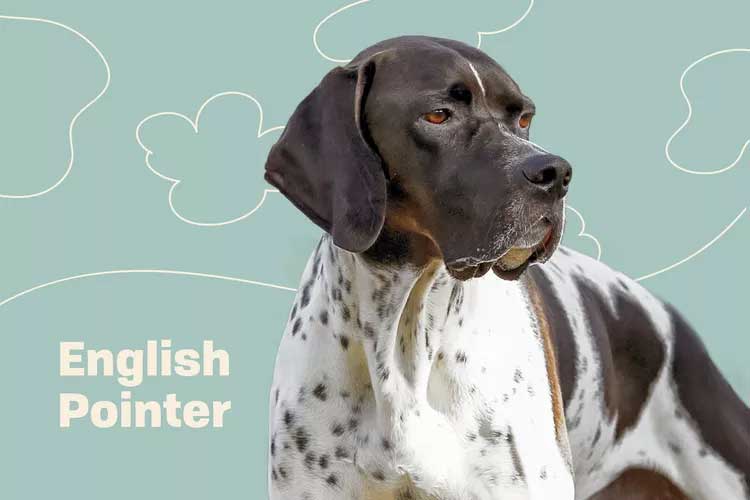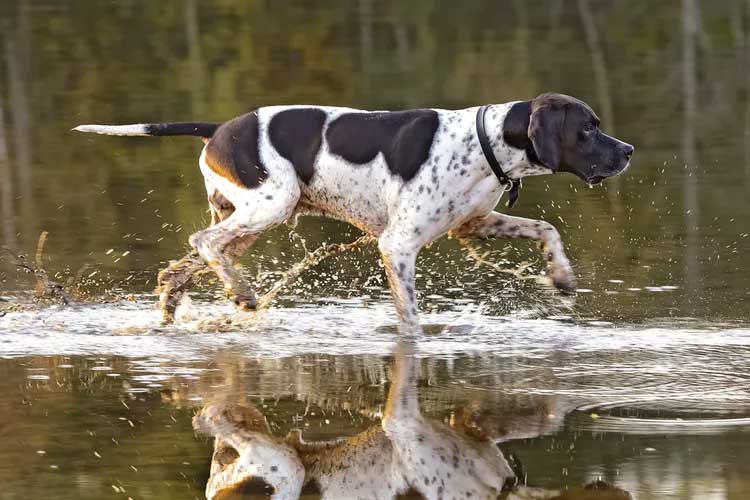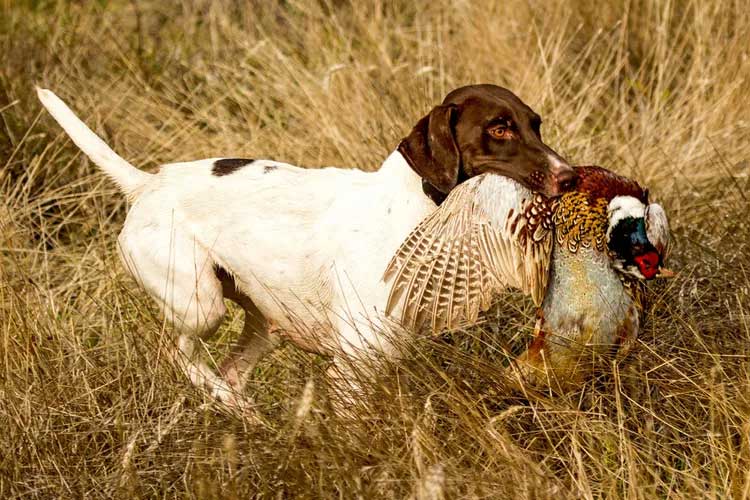Pointers, commonly called English pointers, are intelligent, high-energy dogs who thrive as a hiking or hunting companion.

Pointer (English Pointer) Overview
| OFFICIAL NAME | Pointer (English Pointer) |
| COMMON NAME | Pointer (English Pointer) |
| PET HEIGHT | 23 to 28 inches |
| PET WEIGHT | 40 to 75 pounds |
| LIFESPAN | 12 to 17 years |
| GOOD WITH | children, dogs, families |
| TEMPERAMENT | friendly, playful |
| INTELLIGENCE | high |
| SHEDDING AMOUNT | infrequent |
| EXERCISE NEEDS | high |
| ENERGY LEVEL | active |
| VOCAL LEVEL | infrequent |
| DROOL AMOUNT | low |
| BREED GROUP | sporting |
| BREED SIZE | medium (26-60 lbs.) |
| COAT LENGTH | short |
| COLORS | black, brown / chocolate / liver, white |
| PATTERNS | bicolor, flecked / ticked / speckled |
| OTHER TRAITS | easy to groom, good hiking companion, high prey drive, strong loyalty tendencies, tendency to chew |
Pointers, commonly called English pointers, are medium-sized dogs with big brains and a bold personality. And as the breed's name suggests, the English pointer is known to point towards wild game with their trademark stance: They point with their nose while their tail aligns with their body and head. In fact, it's not uncommon to see an English pointer puppy pointing at just 8 weeks old!
English pointers are independent dogs with a hard-working nature whose history can be traced back for hundreds of years. They're the ideal pup for those who love the outdoors as regular exercise is a must. If you typically fill your weekends with activities including hiking expeditions, bicycle rides, long jogs, or Rollerblading, the English pointer will happily tag along.
Like any dog breed, the English pointer requires proper care, regular exercise, and loads of paws-itive love and attention to thrive. You'll find that they have lots of love to give back in return—in the form of doggy kisses and snuggles.
Appearance
The English pointer is a dog built for speed and endurance. They have short-to-medium-sized ears that hang close to their face with a long muzzle that ends with a slightly upturned nose, which helps add a little extra oomph to their pointing cue.
You'll typically spot English pointers with a bi-colored coat of white with liver, black, or orange-colored patches. You can even find a tri-colored pointer, though those pups are more hard to come by.
Because of the pointer's short and fine coat, they tend to not fare well in cold weather conditions. So if you live in a cold-weather environment or a region that experiences particularly harsh winters, you may want to stock up on cold-weather clothing accessories (including cute dog sweaters and coats) and take precautions on walks outside during the winter season.
His short coat also doesn't require too much maintenance—just your normal brush or wipe-down once a week should suffice. Giving him a bath every four to six weeks is recommended to keep him clean and healthy, but take care not to overwash, as it may lead to his skin drying out.
Temperament
The English pointer is a high-energy, intelligent dog with an independent streak. They are quick to pick up on cues and are very trainable dogs—you just need to put the time in and stay consistent with training.Because the English pointer is such a smarty, he has a tendency to get side-tracked during training sessions. If you, too, get easily side-tracked and have trouble committing to training session blocks, then the English pointer may not be the best match. These dogs truly thrive with someone who can provide blocks of undivided attention.
The English pointer tends to get along well with other dogs, especially if they are raised with them. They can get along with cats fine if they are introduced in puppyhood or well-trained, though, because of their history as hunters, they might be tempted to chase smaller animals. It's not recommended to keep an English pointer in a home with birds or rabbits—these are the small prey they were bred to hunt for.

Living Needs
English pointers are bred as hunting dogs—and they're pretty darn good at it. With this in mind, you can imagine that large, open spaces are the ideal living arrangement for these energetic pooches. They aren't the best apartment dogs, and while a large fenced-in yard isn't 100-percent necessary, the English pointer definitely thrives with lots of space to roam and romp. When they're given opportunities to exercise all of that pent-up energy, you'll have a well-mannered pup on your hands. Long walks and hiking trips are the English pointer's love language.But where the English pointer really shines is on hunting trips. They are great for tracking small prey and, unlike many other hunting dogs, their responsibility and instinct is to point to game—not to retrieve. That said, you may want to take note of lineage before bringing home a puppy from an English pointer breeder. If the litter is born from a long line of hunting dogs and you're not prepared for that energy (and that pointing), you may end up with a handful of a pup.

"Due to the fact that English pointers have a short coat and an active lifestyle, they are prone to skin injuries and lacerations," says Stacy Choczynski Johnson, DVM, Veterinarian Expert at Pumpkin Pet Insurance. "After a long hike or hunt, I recommend checking the skin and paw pads for abrasions. Because this svelte breed is on what I call 'hyperdrive,' they accumulate nicks and scratches a bit faster than a fluffy couch potato."
English pointers shouldn't be left cooped up alone indoors for too long. Without an outlet to expend their energy or anyone to play with, they are likely to become very bored. This could, understandably, lead to destructive behavior in the home. Make sure they have plenty of access to interactive toys to keep them busy whenever they have to be alone.
It's important to note that while he thrives outdoors, that's not the only place your English pointer wants to be. He loves spending time with his family inside the house, too. If you provide an English pointer with the care he needs to flourish, expect frequent cuddling sessions with you and your family after a long day of work or play.
Care
In terms of grooming, caring for an English pointer is pretty straightforward. Their coat sheds lightly throughout the year, so you won't experience a seasonal coat blow. And while their grooming needs are pretty low-maintenance, they require a little TLC every now and then.A light brushing once or twice a week is recommended to keep dirt and loose hair under control, and a bath every four to six weeks will ensure a healthy, shiny coat. Their teeth, on the other hand, are a different story: The English pointer is more prone to dental issues, so keeping up with brushing their teeth three or four times a week is key.

As an active dog breed, an English pointer needs one to two hours of daily exercise. Take them along on your errands, hikes, long walks, and bike rides—they'll absolutely adore this time spent with you.
When it comes to training, as with all breeds, it's a good idea to start when he's young. Your English pointer puppy will benefit greatly from kindergarten classes where he can learn the basics and work on his social skills.
Because of the pointer's instinct for hunting, consistent positive reinforcement is key during training: They may become sidetracked by new noises, smells, or a movement in their peripheral vision. If this is your first time training a dog and you're having trouble keeping your pointer pup's focus even with a handful of treats, it may be worth recruiting a professional for assistance. English pointers are incredibly intelligent dogs that pick up on training cues well—they just need the right guidance.
Health
English pointers are relatively healthy dogs with a long lifespan—they can live anywhere from 12–17 years. But, as with any dog breed, they can develop certain health issues.Some of the most common conditions among English pointer dogs is hip dysplasia, cataracts in young adulthood, epilepsy, and skin conditions or allergies. And if you and your English pointer go out exploring in wetlands or areas with lakes, you'll want to take care with cleanup when you get back home.
"Since pointers hunt game birds, they are often running in wetlands," Choczynski Johnson says. "Frequent exposure to moist environments predisposes dogs to yeast and bacterial infections of the feet, called pododermatitis. I recommend regularly checking for redness on the underside of the paw and giving the feet a good smell check."
History
As with many ancient dog breeds, the English pointer's origin isn't exactly defined. According to the American Pointer Club, there's evidence that dates these dogs to ancient Egypt as well as the Middle Ages in Spain, France, and Italy.Things become more clear in 1719, when officers in the British Army took Spanish pointers back to the U.K. after the War of Spanish Succession. Here, English pointers were further developed for gamebird shooting, according to the American Pointer Club, and often hunted alongside greyhounds.
The breed came to the U.S. in the 1860s, and the English pointer dogs were listed as one of the first nine registered breeds by the American Kennel Club. The list, made in 1878, noted nine highly sought after "charter breeds."
Fun Facts
The English pointers were the first dog to stand game, which means they would locate hidden prey and point in its direction.It can be easy to mix up English pointers with German shorthaired pointers. English pointers stand taller than the German pointers, and were bred specifically to point—GSPs are more of a "do it all" hunting dog.